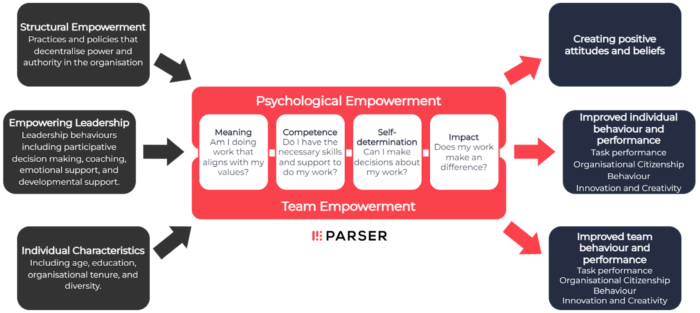Empowerment and Agile
The first foundation of Agile is to empower individuals. Power in organisations is the control of decisions, resources, rewards, rules, and practices. Empowerment is to move power from central leadership to individuals and teams across the organisation. In this post, I outline the modern, widely studied theory of empowerment and look closely at the evidence. This evidence is linked back to Agile, showing how empowerment is a foundation of agile and how it can be improved.
History of Empowerment
The idea of empowering employees can be traced back to the earliest days of management thinking. Henry Gantt, a process engineer, wrote about giving employees definite responsibilities and duties so they are more willing to shoulder responsibility, which still stimulate “courage and initiative” in the 1920s. The modern interpretation of empowerment started with Rosabeth Moss Kanter’s seminal “Men and Women of the Corporation” about how power and diversity shape life in corporations. Since her book was published, the idea of empowerment has been refined, clarified, and extensively studied.
What is Empowerment
With almost 45 years of research in empowerment, there are hundreds of studies, covering thousands of organisations, teams, and individuals across the world giving us a well-established model of empowerment that brings together a wide range of behaviours and outcomes supported by evidence to show how they fit together. Empowerment means to do meaningful work, to have competence in their job, to have self-determination, and to make an impact. The context of empowerment — structural empowerment, empowering leadership and individual characteristics — leads to individual psychological empowerment and team empowerment. Empowerment influences team and individual performance and improves attitudes and beliefs.

What the evidence says
The job of reviewing what we know about empowerment and empowering leadership is made easier by four recent meta-analyses that bring together empirical evidence from hundreds of studies. I have summarised the evidence in terms of how empowerment affects outcomes, and how empowerment is shaped by structural empowerment, empowering leadership, and individual characteristics.
Empowerment and outcomes
The research consistently shows that empowerment does work. Both team and individual empowerment have a moderate impact on performance: a large impact on creativity and relatively less on task performance; in fact, for routine tasks, empowerment can be detrimental. Team empowerment significantly affects team performance, improving both task performance and creativity.
The same pattern shows up with empowering leadership: it has a strong impact on innovation, creativity, and organisational citizenship behaviour (essentially, being helpful); and a more variable impact on task performance. Team and individual empowerment both improve attitudinal measures, with more consistent results. All these performance effects are quite variable: how much empowerment affects performance depends on the context.
Structural empowerment
Empowerment happens in the context of the organisation. Structural empowerment — autonomy given to teams and individuals, having less formal role definitions, and more participatory decision making — explains about a third of the variance in performance. Organisational support — the formal processes and practices such as reward systems, decentralisation, and culture — is closely related to psychological safety. It has a significant influence on empowerment, but slightly less than the more formal aspects of structural empowerment.
Empowering leadership
The largest influence on psychological empowerment came from empowering leadership, one of a cluster of closely related leadership behaviours including servant leadership, transformational leadership, and authentic leadership. However, when looking at outcomes, empowering leadership has a relatively small and quite inconsistent effect on both team and individual performance. It has a stronger effect on attitudes: feelings of empowerment and trust in the leader.
Individual factors
Two individual characteristics showed up as mitigating factors for empowering leadership. Firstly, empowering leadership had a bigger impact on new staff in the organisation. Secondly, empowering leadership had a stronger relationship in countries considered more collectivist (e.g. Asia and Latin America) and a smaller relationship in countries considered more individualistic (e.g. North America). When both of these things are true, then empowering leadership has a significant effect on performance.
Empowerment and Agile
Having empowered teams and individuals, one of the foundations of Agile is: without genuine empowerment, an agile implementation is less likely to be successful. In this final section, I take the findings from the research on empowerment and link them to Agile.
The most important finding is that the decades of research into empowerment support core agile practices. Autonomous teams, coaching, decentralised decision making, all foster empowerment which improves individual and team performance, as well as attitudes. But this finding needs to be qualified with some further comments.
Empowerment is not a perfect tool: it will help, but it is not a silver bullet. It will improve creativity and a range of social attitudes and behaviours that produce a more engaged and committed workforce — all critical building blocks to the success of agile. It may have less impact with relatively simple, routine tasks; but these are less common in an agile organisation. Overall, without empowerment, the creativity of agile will be stunted.
Given how important empowerment is, it is worth measuring. To support empowerment, organisations should directly understand from their teams and individuals:
- Are you doing meaningful work that aligns with their values?
- Do you have the necessary skills to do your job?
- Can you make decisions about your work and how it is done?
- Is your work making an impact?
These questions directly assess empowerment and form a key signal that you are empowering your teams.
If your team does not feel empowered, a likely source is structural empowerment. Distributing control over decisions, resources, rewards, rules, and practices from senior leaders across the organisation enables empowerment. Formal decentralisation needs to be supported by the social organisation, creating psychological safety and security. Decentralisation of power is incredibly difficult, particularly for successful organisational leaders; but without consciously addressing structural empowerment, the success of agile will be diluted.
Finally, the evidence highlights the importance of empowering leadership: participative decision making, coaching, emotional support, and developmental support. Empowering leadership will improve creativity and is the most significant factor in improving beliefs about empowerment — all critical to the success of agile in an organisation. These effects are stronger with relatively new people in the organisation and in more collectivist rather than individualistic cultures.
Empowerment is essential to a successful agile organisation. The good news is we know a lot about empowerment: it is well-defined, specific, and well-studied. By drawing on the evidence it shows that empowerment is one of the keys to improving job satisfaction and unlocking creativity at work. To achieve empowerment, it is essential to assess empowerment and to both provide empowering leadership and to review the structures of empowerment in the organisation.
References
Kanter, R. M. (1977). Men and women of the corporation. New York: Basic Books. https://www.hbs.edu/faculty/Pages/item.aspx?num=10807
Lee, A., Willis, S., & Tian, A. W. (2017). Empowering leadership: A meta-analytic examination of incremental contribution, mediation, and moderation. Journal of Organizational Behavior, 39(3), 306–325. https://doi.org/10.1002/job.2220
Kim, M., Beehr, T. A., & Prewett, M. S. (2018). Employee responses to empowering leadership: A meta-analysis. Journal of Leadership & Organizational Studies, 25(3), 257–276. https://doi.org/10.1177/1548051817750538
Seibert, S. E., Wang, G., & Courtright, S. H. (2011). Antecedents and consequences of psychological and team empowerment in organizations: A meta-analytic review. Journal of Applied Psychology, 96(5), 981–1003. https://doi.org/10.1037/a0022676
Mathieu, J. E., Gilson, L. L., & Ruddy, T. M. (2006). Empowerment and team effectiveness: An empirical test of an integrated model. Journal of Applied Psychology, 91(1), 97–108. https://doi.org/10.1037/0021-9010.91.1.97

